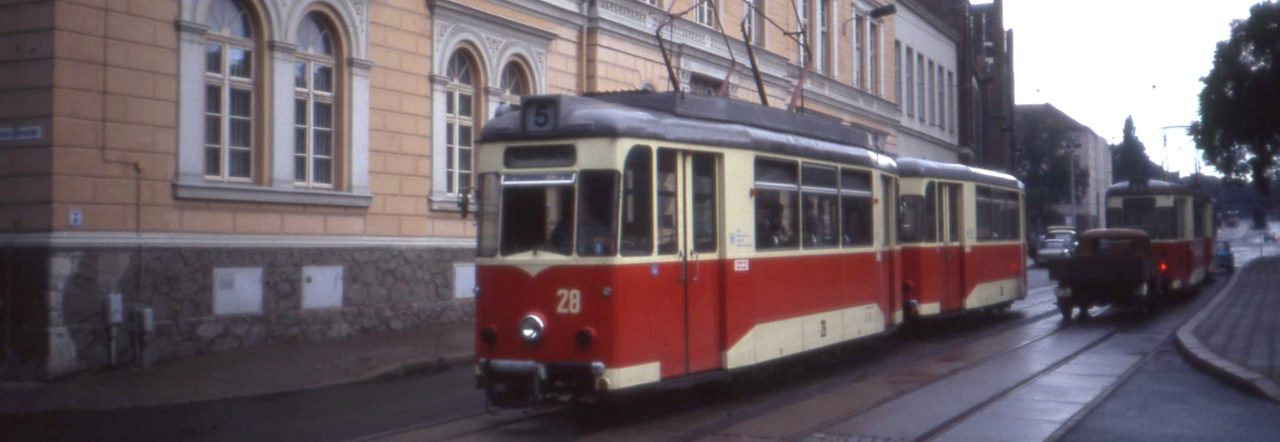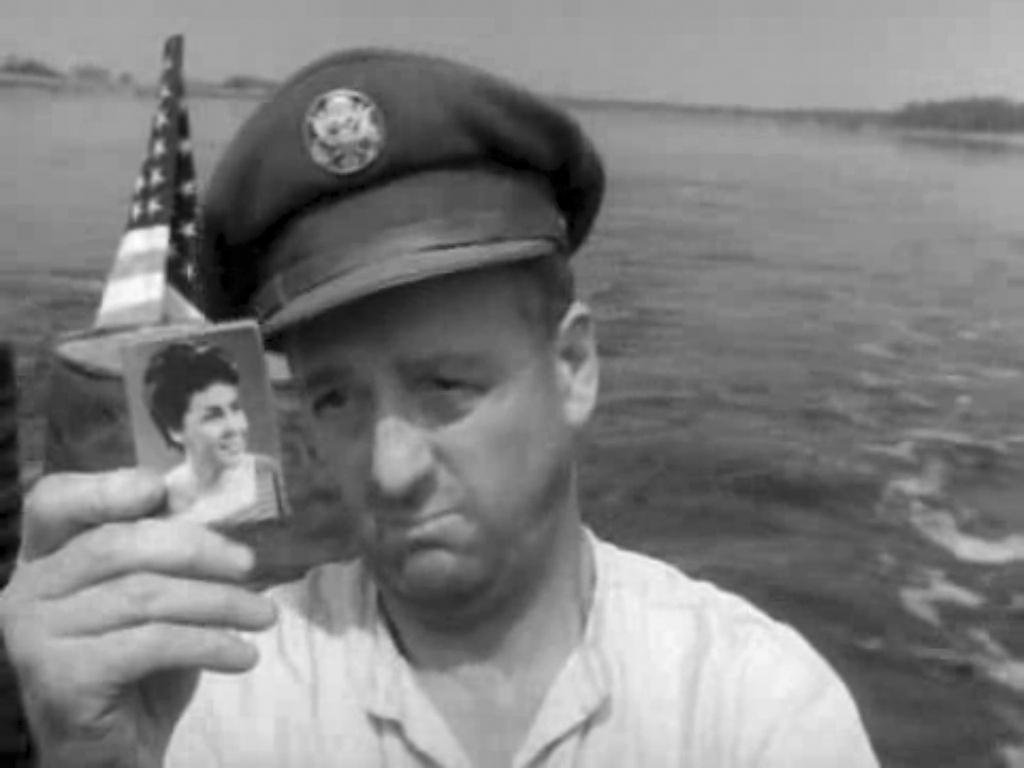By the early 1960s, the Cold War was hotter than ever. The Cuban revolution in 1959, the building of the Berlin Wall in 1961, and the Cuban Missile Crisis in 1962 led to a situation where people on both sides of the Iron Curtain were expecting World War III to start at any minute. So what does one do with things look their grimmest? One laughs, of course—especially at the other guys. Billy Wilder had already explored this territory in 1939 with Ninotchka, and again in 1961 with One, Two, Three—a film that has the dubious distinction of being made just as the wall was being built—but now it was East Germany’s turn to explore the rift between the east and west in as light-hearted a manner as possible.
The year was 1963, and the film was Carbide and Sorrel (Karbid und Sauerampfer). It’s loosely based on the true story of a man named Richard Hartmann, who was given the job of schlepping several barrels of carbide from Wittenberg to Dresden (about 135 km)—without a vehicle—at the end of World War II.
To fully appreciate this film, a little history is in order. Dresden after the war was in ashes. A coordinated bomb attack by the allied forces left 35,000 people dead and 39 square kilometers (15 square miles) of the city in flames. At one point during the bombing, the fire was so large that the bombers stopped dropping flares to mark the target—the flames made it obvious. The fire was so intense that it created swirling tornadoes of flames that sucked the oxygen from everything around it. Thousands died of asphyxiation, trapped in air raid shelters. They were the lucky ones. Others were burned to death, some so severely that all that was left of their bodies were the fragile, ashen remains. Most Americans knew little about this event until Kurt Vonnegut, who had the dubious distinction of being there at the time as an American P.O.W., described it in his magnum opus, Slaughterhouse Five. Prior to the fire-bombing, Dresden was considered one of the most beautiful cities in Europe, called the “Florence of the Elbe” (Elbflorenz) for its beautiful architecture and art. In terms of industry. Dresden was known for two things: cameras and cigarettes. In the 1930s, Dresden produced 60% of all German tobacco products. Even today, one of the historical landmarks of the city is the Yenidze, a former tobacco factory that resembles a Middle Eastern mosque. No longer a factory, it is used now primarily for offices and is a historical landmark.
In Carbide and Sorrel, the former cigarette factory workers decide to get the factory up and running again. To do this, they need to do some welding, and welding needs carbide. A man named Kalle is enlisted to bring the carbide back to Dresden from the factory in Wittenberg. Kalle, beautifully played by Erwin Geschonneck, is chosen because he is single, so he has no family to worry about, and, more importantly, his brother-in-law owns a carbide factory. He is also a vegetarian, which, the others feel, will help him live off the land during his trip. The good-natured Kalle reluctantly agrees and off he trudges to Wittenberg.
After leaving the carbide factory with seven 100-pound barrels, he gets his first ride from a woman named Karla, who lives a stone’s throw from the factory. It’s not much distance, but Kalle likes Karla. He agrees to go with her and spends the rest of the day and that night at her farm. Karla dreams of becoming an actress. She collects movie magazines and has had small mirrors made with her picture on the back. She gives Kalle one of these mirrors to remember her by, and Kalle promises to return to her after he gets the carbide to Dresden. What follows is a series of misadventures in which Kalle encounters all manner of scoundrels and thieves. He also has several run-ins with the Soviet army and a comic encounter with an American soldier.
It is interesting to compare this film to its American counterparts. In Hollywood films of the period, U.S. soldiers are portrayed as upstanding and ruggedly handsome, while Russians are almost always portrayed as fat and corrupt. In Carbide and Sorrel, we are presented with the mirror view. Here, it is the Russian soldiers who are handsome and honest. The sole American he encounters is a fat buffoon with rotten teeth. Kalle steals the American’s boat, but this act is not seen as a crime any more than Cagney’s swindling of the Russian diplomats in One, Two, Three is viewed as immoral. They are the bad guys, and anything you do to them is okay. The one young woman Kalle encounters who wants to go to America is portrayed as vapid and self-serving, suggesting that only a stupid person would think things are better in the West.
Erwin Geschonneck was already becoming one of East Germany’s most popular actors. His turn in Naked Among Wolves was well-received on both sides of the wall, but it was the part of Kalle in Carbide and Sorrel that made him the most popular actor in East Germany. Years after the wall came down, he was voted the “best East German actor ever” in a survey taken by Film und Fernsehen magazine. As an interesting side note, the idea for making Kalle a vegetarian came from Erwin Geschonneck, who was also a vegetarian. Although it is more common today, being a vegetarian in Germany in the early sixties (on either side of the wall) was considered extremely odd.
Geschonneck’s own life was every bit as adventurous as that of Kalle’s. During World War II, he was one of the 4,500 concentration camp prisoners on the Cap Arcona, a former luxury liner that was being used as a prison boat by the Nazis. Thinking the ship was being used to transport troops, the RAF sank the boat in April 1945. The SS guards, equipped with life jackets, proceeded to shoot any prisoners who attempted to escape the sinking ship. Only 350 of the prisoners survived, and the bones of the dead continued to wash ashore on the Bay of Lübeck until 1971. Geschonneck’s story was made into a TV movie in 1982: Der Mann von der Cap Arcona. Geschonneck retired after the wall came down, returning only once to television to star in Matulla und Busch—a TV movie directed by his son Matti Geschonneck.
Director Frank Beyer was at the height of his career in 1963. His previous films, Five Cartridges and Naked Among Wolves were both successful, but they were also grim. With Carbide and Sorrel, Beyer proved that he could do light comedy as well. Beyer uses classic film tricks for humorous effect, such as speeding up or reversing the action, and the use of novelty wipes for scene transitions, but most of the humor comes from Geschonneck’s put-upon Kalle, and his wonderful range of facial expressions, coupled with Joachim Werzlau’s cheerful soundtrack.
Composer Joachim Werzlau worked exclusively with Beyer for his last few film scores. From 1963 on, he preferred to work in the field of classical music, producing several orchestral pieces and operas, including the communist opera Meister Röckle, which was often performed in East Germany and in Moscow, but is rarely performed today. The only full film score he created after Carbide and Sorrel was Jacob the Liar, which was also directed by Frank Beyer
Thanks to films such as Carbide and Sorrel and Jacob the Liar, Beyer was respected as one of the greatest East German directors by the time the Wall fell. But this stature did not come without setbacks and travails (more on this later).
IMDb page for Carbide and Sorrel
If you like what I do here and would like to let me know, you can buy me a cup of coffee by clicking on the button to the left.
© Jim Morton and East German Cinema Blog, 2025. Unauthorized use and/or duplication of this material without express and written permission from this site’s author and/or owner is strictly prohibited. Excerpts and links may be used, provided that full and clear credit is given to Jim Morton and East German Cinema Blog with appropriate and specific direction to the original content.




I have never heard of this film. Thanks to your great article I will now go looking for it!
You might be interested to learn that you can watch the entire film for free with on Veoh.com after a quick uncomplictaed installation of the Veoh-webplayer!
Moni, thanks for the tip! I’ve heard good things about Veoh, and it looks like it offers an excellent assortment of the early DEFA films that I talk about in my blog. I should warn readers who don’t speak German that there are no subtitles.